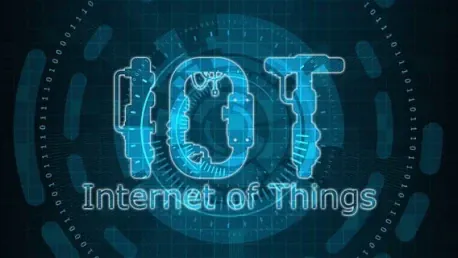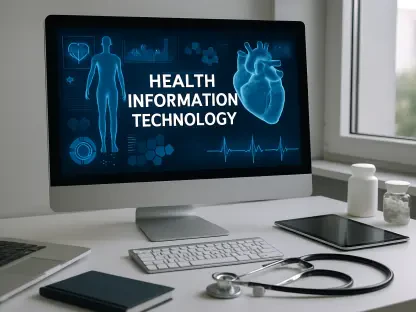The article delves into the vital role that supporting a modern IoT (Internet of Things) platform plays in advancing physical security systems. IoT heralds an era where traditional static elements are infused with technology to create efficiencies and open up limitless possibilities for businesses and societal growth. This technological transformation is reshaping how physical security systems are designed, operated, and maintained. Components such as video recording equipment, access controls, alarm systems, locks, and monitoring services have seen significant evolution alongside the software that operates and sustains them.
The Evolution of Physical Security Systems
From Standalone Systems to Integrated Solutions
Before the advent of IoT technology, physical security relied on standalone systems such as surveillance cameras with limited resolution and storage, landline alarm systems, and mechanical locks—all of which required manual intervention. Maintenance and updates involved scheduling onsite visits, which left customers waiting for service. In contrast, today’s IoT devices have revolutionized security by enabling real-time monitoring, remote access, and automation of security processes.
The transformation brought about by IoT means that systems once functioning in isolation now work together, creating an interconnected security network. This advancement allows access controls to communicate with alarm systems and video surveillance units, providing a comprehensive security solution. An integrated approach ensures a higher level of security as the system can detect anomalies more efficiently and provide a prompt response to potential threats. This shift in security management significantly reduces the need for manual oversight, freeing up resources for more critical tasks.
Meeting Higher Customer Expectations
Customers now expect immediate answers and faster resolution of issues without the delays associated with traditional maintenance. The demand for instant support and maintenance has increased the burden on OEMs’ support and maintenance teams. According to ASIS, the security services market, encompassing both installation and equipment maintenance, is forecast to grow to $117 billion by 2026. This growth is driven by organizations investing more in predictive maintenance systems and remote monitoring, shifting towards preventative measures and integrated platforms.
The capabilities offered by IoT solutions are indispensable in meeting rising customer expectations. Remote diagnostics, real-time data analysis, and immediate alerts enable swift identification and resolution of issues, fostering customer satisfaction. Additionally, predictive maintenance models leverage machine learning to analyze data and predict potential failures before they occur. These advancements reduce downtime, optimize product performance, and ultimately contribute to customer loyalty and trust. Providing such forward-thinking solutions positions OEMs as leaders in the competitive physical security market.
Benefits of Using an IoT Platform
Faster, Always-On Customer Service
IoT platforms enable OEMs to connect, verify, and respond to incidents in real-time, resulting in quicker support and response cycles. This capability is crucial in meeting the heightened expectations of customers who demand immediate solutions to their security concerns. In today’s environment, any delay in addressing security issues can lead to significant risks and potential breaches. By leveraging the capabilities of an IoT platform, OEMs can offer a responsive and reliable service, ensuring that customer needs are promptly met.
Furthermore, an always-on service capability aligns with the global nature of business operations where security concerns can arise at any time. The continuous connectivity provided by IoT platforms allows for round-the-clock monitoring and support, a critical requirement for businesses that cannot afford any gaps in their security operations. This uninterrupted service ensures that clients receive the highest level of security management around the clock, regardless of their geographical location or time zone.
Proactive Maintenance and Support
Customers seek preventative maintenance achievable only through proactive monitoring, capturing, and analyzing real-time data. A robust IoT platform offering real-time data and over-the-air (OTA) functionality is critical for delivering proactive maintenance. This approach helps in identifying potential issues before they escalate, ensuring continuous and reliable security operations. Proactive maintenance reduces the risk of unexpected system failures and minimizes the need for emergency repairs, which can be costly and time-consuming.
The adoption of IoT platforms also fosters a culture of preventative maintenance that extends beyond simple monitoring. Advanced data analytics and artificial intelligence techniques allow OEMs to predict maintenance needs and schedule service interventions ahead of time. This helps in maintaining optimal performance levels and prolonging the life cycle of security equipment. For customers, the assurance of continuous, trouble-free operation enhances their confidence in the security solutions provided, leading to stronger customer relationships and potential business growth.
Managing Software Updates
Issues in IoT-enabled products are often software-related. Efficient infrastructure for remote deployment of patches, bug fixes, or new updates is necessary. An IoT platform provides a secure and efficient way to manage these updates, ensuring that devices remain up-to-date and secure against potential vulnerabilities. Regular updates are crucial to maintaining device integrity and effective functioning. By providing a streamlined process for software management, IoT platforms facilitate the seamless deployment of updates across all devices in a network.
The ability to manage software updates remotely is particularly beneficial for large-scale deployments where manual updates would be impractical. By automating the update process, OEMs can ensure that all devices receive the latest security patches and functionality improvements without the need for physical intervention. This reduces operational costs and eliminates the downtime associated with traditional update methods. Moreover, this automated approach guarantees that all devices across the customer base are uniformly protected against new and emerging threats.
The Complexity of IoT Solutions
Increased Complexity and Software Integration
Before the rise of smart physical security, issues typically arose from faulty cables, connections, or equipment breakdowns. Today’s IoT-enabled devices and applications are considerably more intricate, often requiring millions of lines of software code. This complexity, combined with the accompanying infrastructure and systems, has increased exponentially with different product iterations, versions, and software compatibility challenges. Support teams now face the challenge of managing diverse, sophisticated systems that demand a thorough understanding of both hardware and software components.
The increased complexity necessitates comprehensive training programs for support personnel to effectively handle the multi-faceted nature of IoT-enabled security systems. These programs must cover the latest software developments, troubleshooting techniques, and effective communication strategies to resolve customer issues efficiently. A deeper understanding of IoT architecture and integration ensures that support teams can provide reliable and informed assistance, ultimately enhancing the customer experience and ensuring the secure operation of the deployed security devices.
Robust Solutions for Comprehensive Monitoring
Effectively supporting IoT devices in physical security requires robust solutions capable of delivering comprehensive monitoring, troubleshooting capabilities, and managing software-centric products. Regular updates are necessary to eliminate vulnerabilities that attackers might exploit. OEMs bear the responsibility for these updates, and an IoT platform provides a secure, efficient way to manage fleet-wide updates. Continuous monitoring allows for the collection of real-time data, which forms the basis of predictive analytics and intelligent maintenance strategies.
A diverse range of sensors and monitoring tools integrated into IoT platforms can detect even the slightest anomalies in device performance. This capability empowers OEMs to address potential issues before they impact security operations. Additionally, the use of secure channels for data transmission and authentication processes ensures that updates and monitoring activities do not compromise the security framework. Comprehensive monitoring and seamless update processes are critical to maintaining the reliability and effectiveness of IoT-enabled security systems, reinforcing customer trust and satisfaction.
Ensuring Security and Compliance
Device Authentication and Fleet-Wide Monitoring
To prevent unauthorized access, each connected device within IoT security systems must be authenticated. Proactive, fleet-wide monitoring ensures issues are addressed before they become severe, protecting the OEMs’ reputation. Real-time data analysis and monitoring play a crucial role in maintaining the integrity and security of the entire system. Authentication mechanisms such as two-factor authentication (2FA) and digital certificates help secure device communication channels and data exchanges.
The implementation of fleet-wide monitoring practices enables OEMs to maintain a clear overview of all devices in operation. By consistently tracking device status and performance metrics, OEMs can rapidly identify and respond to security threats. Automated alerts generated by the monitoring system provide immediate notification of any irregular activities, allowing for quick remedial action. These efforts to enhance security and compliance protect both the customer and the OEM, fortifying the overall security infrastructure and fostering a culture of reliability and trust.
Remote Troubleshooting Capabilities
The ability to troubleshoot issues remotely is vital once devices are deployed. Robust monitoring systems allow OEMs to detect issues instantly, while remote troubleshooting capabilities enable them to address problems promptly, thus preventing disruptions. This capability is essential for maintaining the reliability and effectiveness of IoT-enabled security systems. Remote troubleshooting reduces the need for physical interventions, saving time and resources while ensuring that security systems remain operational around the clock.
Advanced diagnostic tools integrated into IoT platforms facilitate the identification and resolution of complex issues. These tools offer detailed insights into device performance and network conditions, providing support personnel with the necessary information to resolve problems efficiently. By leveraging remote access capabilities, OEMs can perform tests, deploy updates, and make configuration changes without requiring on-site visits. This proactive approach minimizes downtime and enhances the overall efficiency of the security system, reinforcing the value proposition of IoT-enabled solutions.
Continuous Improvement and Support
The Importance of Continuous Integration and Delivery
The job of an OEM does not conclude with launching a new product. In fact, 60% of a software’s lifecycle costs arise from maintenance, while only 40% come from development. To stay competitive and relevant, OEMs need strategies and platforms that support continuous integration and continuous delivery (CI/CD) within the development cycle, ensuring regular improvements and maintenance of IoT security solutions. CI/CD practices enable rapid development, testing, and deployment of new features and updates, fostering innovation and adaptation.
Implementing CI/CD methodologies allows OEMs to iterate quickly, responding to emerging customer needs and security challenges. Continuous integration involves the merging of all developers’ changes to the main codebase frequently, facilitating early detection of defects and ensuring code quality. Continuous delivery, on the other hand, automates the release process, reducing the time and effort required to bring new updates to production. This streamlined development cycle ensures that IoT security solutions evolve in line with technological advancements and customer expectations.
Adapting to Evolving Customer Demands
The article explores the crucial role a modern IoT (Internet of Things) platform plays in enhancing physical security systems. IoT introduces an era where traditional static components are embedded with technology, creating efficiencies and offering unlimited possibilities for business and societal growth. This technological shift is transforming the design, operation, and maintenance of physical security systems. Key elements such as video recording equipment, access controls, alarm systems, locks, and monitoring services have significantly evolved. The software that drives and supports them has also seen substantial advancements. Businesses and organizations are embracing these technological enhancements to develop more robust and responsive security frameworks. IoT integration in physical security systems not only improves operational efficiency but also provides real-time data, enhancing the ability to respond to security threats promptly. This constant evolution underscores the importance of adopting and supporting modern IoT platforms to ensure the security infrastructure stays ahead of emerging challenges and threats in a rapidly changing technological landscape.









